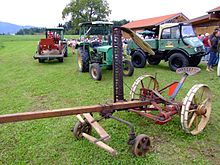Finger mower
The finger mower is the most common type of bar mower in agriculture for mowing or cutting plants. A knife is moved back and forth in fingers, which serve as a counter blade. The distance between the two reversal points (knife dead points) is called the stroke. The knife division, d. H. the width of a knife blade is usually 76 mm. The knife is usually driven with the help of a crank and push rod, an eccentric or hydraulically. Up to 2000 strokes per minute are common. Finger mowers are characterized by their low power requirement and, due to the low speeds of the moving parts (max. 5 m / s), they can be used without major safety precautions. This mowing technique works on the principle of scissors cutting .
Designs
A distinction is made between different designs with regard to the cutting quality.
- Deep cut: Here 2 fingers are mounted per knife division. This mower provides a very precise cutting pattern, but is rarely used due to its susceptibility to clogging.
- Middle cut: Here 1.5 fingers are mounted on a stroke of 76 mm. There are 2 knives on 3 fingers. The finger division is 50.8 mm. This type of construction is preferably used in grassland management.
- High cut: there is a finger for every knife division. The finger division is thus 76 mm. The cut is the worst here. As a special feature, a long stroke over two fingers is built in addition to the usual short stroke over a finger division, which leads to twice the knife speed and thus to a higher mowing performance.
advantages
Nowadays, finger mowers are preferred in mountainous terrain with motor mowers due to their light construction and low power requirements . Because of the rapid deployment capability, they are still in the side or rear mounting on mainly older tractors or to hang capable implement carriers used in front-mounted. Even with short cut material, they still deliver a beautiful cut. The slow working speed also gives slower wild animals and small animals at the edges of paths and forests sufficient time to escape.
disadvantage
Since sharp blades and a full knife support for a flush counter blade are necessary for functionality, a high level of maintenance and care must be carried out. The risk of clogging increases sharply in difficult conditions (wetness, storage). The low working width and speed in the grassland area limit the area coverage. Another disadvantage is that the cutting height cannot be adjusted in practice; it results from the construction of the cutter bar.
Areas of application
The main focus used to be on mowing grass in the meadows. The main areas today are in areas that cannot be cultivated with large machines, e.g. B. in the mountains or in impassable wetlands. There they are often used as motor mowers .
Today's main focus is on grain harvesting technology. In the cutting units of the combine harvesters , the cutter bar achieves a cutting width of up to 9 m. Since the layplan is of secondary importance there and functionality is in the foreground, the high cut is preferred. The bar is supported by the reel, which combs / tilts the cut grain plants away from the cutter bar and thus works reliably even under difficult harvesting conditions such as storage etc.
Also working hedge trimmers , clippers and lawn edger on this principle.
literature
- Agriculture: Volume 3 - Agricultural engineering and construction . BLV Verlagsgesellschaft, Munich, ISBN 3-405-14349-7


